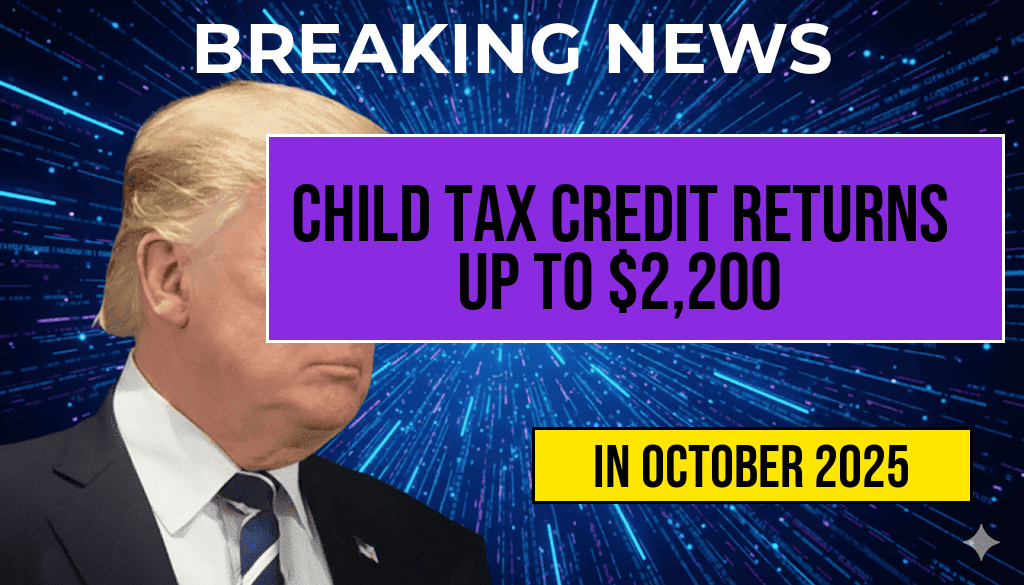As the new year approaches, many American families are preparing for the resumption of the Child Tax Credit, a vital financial resource that can provide up to $2,200 per qualifying child. After a temporary expansion during 2021, which offered increased payments and broader eligibility, the program is returning to its pre-pandemic structure but with some notable enhancements. Families with children under 17 should review the upcoming changes carefully, as they could significantly impact their annual household budgets. The IRS has announced that qualifying families can expect to receive monthly or lump-sum payments based on their income and household size, making the tax credit more accessible and easier to claim.
Understanding the 2024 Child Tax Credit Framework
Eligibility Criteria and Income Limits
- Age of children: Children must be under 17 at the end of the tax year.
- Income thresholds: The full credit is available for families earning up to $75,000 (single filers), $112,500 (head of household), and $150,000 (married filing jointly). Income above these limits reduces the credit gradually.
- Taxpayer identification: Valid Social Security numbers are required for both the parent and the child.
Credit Amounts and Phasing Out
| Filing Status | Maximum Credit Per Child | Phase-Out Begins At |
|---|---|---|
| Single / Head of Household | $2,200 | $75,000 |
| Married Filing Jointly | $2,200 | $150,000 |
The maximum amount families can receive remains at $2,200 per qualifying child, but the credit phases out beyond the specified income thresholds. For incomes exceeding these limits, the credit diminishes by $50 for every $1,000 over the threshold until it phases out entirely.
How Families Can Claim the Child Tax Credit
Filing Requirements and Documentation
To access the Child Tax Credit, eligible families must file a federal tax return, even if they do not usually owe taxes. The IRS encourages families to use the Free File program or other free filing options if they qualify. When filing, families should provide accurate information about their income and dependents, including Social Security numbers for each child.
Advance Payments and Refundability
Unlike previous years, the IRS is offering the option for families to receive advance payments of the Child Tax Credit starting in July 2024. These payments are designed to provide ongoing financial support and reduce the annual tax burden. The remaining portion of the credit can be claimed when filing the year-end tax return. Importantly, the Child Tax Credit remains fully refundable, meaning families can receive the full benefit even if they owe no taxes.
Impacts on Families and Economic Considerations
Financial Relief and Budget Planning
The reinstatement of the Child Tax Credit provides a significant boost for families navigating rising childcare costs, housing expenses, and education fees. According to recent studies, the credit can help reduce child poverty and support parental employment by alleviating some financial stress. For families with multiple children, the cumulative benefit can reach several thousand dollars annually, making a tangible difference in household stability.
Policy Developments and Future Outlook
The Biden administration has emphasized the importance of extending and expanding the Child Tax Credit to support economic recovery efforts. Legislative proposals continue to explore ways to make the credit more inclusive and substantial, potentially increasing the maximum benefit or adjusting income thresholds. Policy analysts suggest that sustained investment in child welfare programs could yield long-term societal benefits, including improved educational outcomes and health metrics.
Resources and Assistance for Claiming the Credit
- IRS Child Tax Credit official page
- Consumer Financial Protection Bureau guide
- Wikipedia overview of U.S. Child Tax Credit
As the new tax season approaches, families are advised to gather necessary documentation early and consult IRS resources or qualified tax professionals to maximize their benefits. With the Child Tax Credit returning to its previous structure, millions of households stand to gain vital financial support that can help shape brighter futures for their children.
Frequently Asked Questions
What is the Child Tax Credit?
The Child Tax Credit is a tax benefit designed to help families with qualifying children reduce their tax burden and receive financial support. In the upcoming year, families can receive up to $2,200 per qualifying child.
Who qualifies for the Child Tax Credit?
Families with children under age 17 who meet certain income and relationship criteria are eligible. The child must be a dependent and a U.S. citizen or resident. Income limits apply, and higher earners may see a reduction in the credit amount.
How much can families receive through the Child Tax Credit?
Families can receive up to $2,200 per qualifying child. The exact amount depends on income, filing status, and the number of eligible children. Some families may also qualify for additional credits or refunds.
When will families receive the Child Tax Credit payments?
Eligible families can expect to receive monthly payments starting in the upcoming year, with the total amount based on their submitted tax returns. These payments are designed to provide ongoing financial support throughout the year.
How do families claim the Child Tax Credit?
Families can claim the Child Tax Credit when filing their tax returns. They should ensure their dependents are properly listed and meet all eligibility criteria. Additional eligibility details are available on the IRS website or through a tax professional.










